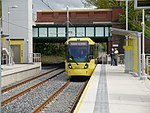Alexandra Park Aerodrome

Alexandra Park Aerodrome was the second purpose-built aerodrome in the Manchester area in England. The site was chosen by the War Department in 1917 because of its open agricultural nature, and lay between the neighbouring districts of Fallowfield, Chorlton-cum-Hardy, Whalley Range, Withington and West Didsbury, at the junction of Princess Road and Mauldeth Road West, three miles south of Manchester's city centre: the land was owned by the Egerton Estate. The aerodrome's brief existence is commemorated on a plaque in the sports pavilion at Hough End Playing Fields, which now occupy part of the site. A commemorative plaque was unveiled on 7 July 2007 to mark the 90th anniversary of the aerodrome and is located in the grounds of No. 184 (Manchester South) Squadron, Air Cadets, in Hough End Crescent.
Excerpt from the Wikipedia article Alexandra Park Aerodrome (License: CC BY-SA 3.0, Authors, Images).Alexandra Park Aerodrome
Houghend Crescent, Manchester Whalley Range
Geographical coordinates (GPS) Address Nearby Places Show on map
Geographical coordinates (GPS)
| Latitude | Longitude |
|---|---|
| N 53.4364 ° | E -2.2502 ° |
Address
Houghend Crescent
Houghend Crescent
M21 7TD Manchester, Whalley Range
England, United Kingdom
Open on Google Maps








